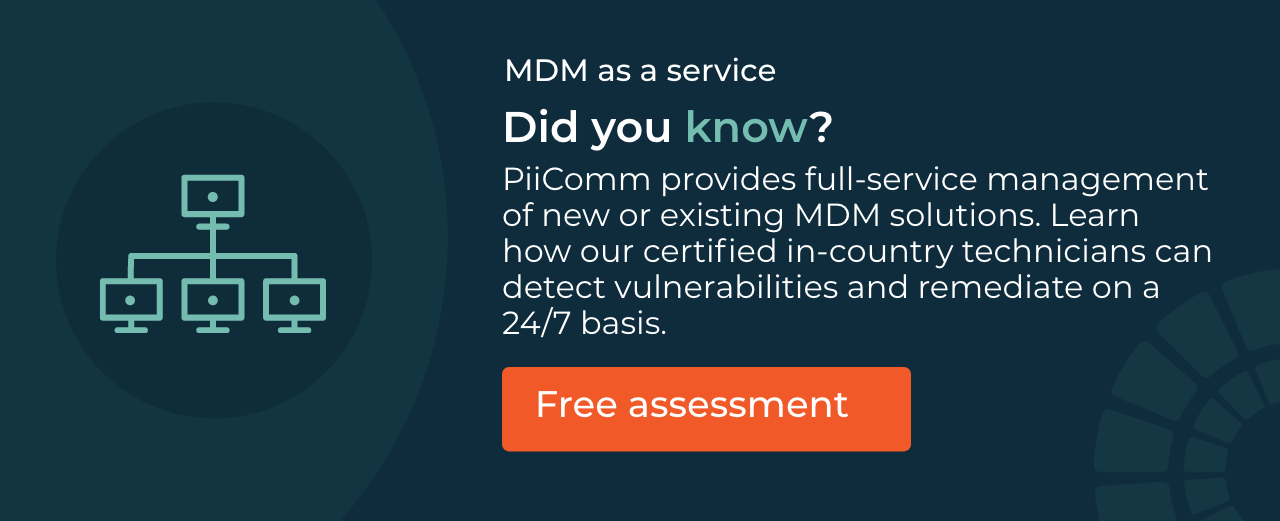
Internal IT teams face an ongoing challenge of balancing innovation with operational demands. A recent Foundry survey showed that 75% of CIOs struggle to drive innovation while managing critical tasks like security, patching, and IT performance. These essential responsibilities often consume the resources needed for strategic projects, leaving IT teams stretched thin.
Mobile device management (MDM) is a prime example of this burden. With spending on mobile devices in the US hitting $732 billion in 2024, and teams more dispersed than ever, managing these device fleets has become increasingly complex and time-consuming. This creates a significant strain on already overburdened IT teams.
Outsourcing MDM is a solution. This article explores the challenges in-house IT teams face with mobile device management and how MDM as a Service can ease the administrative load, allowing teams to focus on higher-priority work.

The challenges of handling mobile device management (MDM) in-house
As mentioned, mobile device deployment across remote and hybrid workforces continues to grow in terms of both overall spend and the number of in-field devices. The complexity of these devices is also accelerating.
Notable trends in mobile device management extend beyond traditional laptop, phone, and utility equipment deployments. There’s also significant growth in the deployment of Internet of Things (IoT) devices, edge computing and AI services, and augmented reality-enabled devices for use in field operations.
The growing complexity—and volume of devices—gives rise to a myriad of security and operational risks that can impact the overall stability of your mobile device fleet. Managing this in-house, of course, becomes more challenging as this complexity rises.
Here are some key challenges that arise from this growth in complexity.
Time-consuming device setup and configuration
Setting up and configuring mobile devices for employees takes a considerable amount of time and internal resources. That burden is, of course, multiplied by the number of employees and the number of individual devices they carry.
This is especially true when each device in a mobile fleet needs to meet specific security protocols, organizational standards, and be connected properly with the rest of the IT infrastructure.
Manual provision of these devices for new employees—or ongoing re-provisioning efforts for existing ones—eats significant IT resources in the long term.
Managing diverse devices and operating systems
In-house IT teams are often tasked with managing a wide variety of mobile devices, including both standard and specialized tools. Smartphones, tablets, and laptops are typical but, depending on the industry, this management might extend to rugged devices for field services, connected IoT devices, POS systems, and more.
Each of these devices will have different setup up and management configurations, including operating systems and security requirements. Ensuring all of these devices are configured properly, updates, and continuously secure becomes increasingly difficult as the number of devices and platforms grows.
Keeping up with frequent security updates and patches
As mentioned above, mobile devices of all kinds require regular security updates, patches, and monitoring to prevent vulnerabilities that can lead to data breaches and compromised IT systems.
In-house IT teams need to monitor and deploy security updates for each device in real-time, which is time-consuming and leaves the door open for errors and oversight. Again, as the complexity and scope of the mobile fleet increases, the opportunities for security breaches also increases, raising the risk level for the organization considerably.
Lack of real-time monitoring and issue resolution
For smaller in-house IT teams, there may be an inability—or a diminished ability—to continuously monitor device performance, usage, and security vulnerability in real time. This requires specialized tooling that needs to also be configured and deployed in-house.
MDM providers offer these monitoring capabilities, but it’s not always feasible with in-house IT resources. As a result, it can be easy for in-house teams to miss events like software malfunctions, connectivity issues, or security breaches that can lead to significant network disruptions.
Increased IT support tickets
Any in-house team understands the resource burden that comes with being the sole source of support for any and all IT issues that pop up across the organization.
The more devices that an organization manages in-house, the higher the volume of support requests that your team will receive. And this number will increase even further as vulnerabilities and connection issues grow due to the challenges listed above.
Tickets, in this context, may range from troubleshooting technical issues to addressing software malfunctions or security breaches. More devices, as mentioned, leads to more tickets, which adds further burden to an already overextended in-house IT team.
Lack of scalability as the business grows
Of course, as your business grows, you add more employees and devices. Managing that expanding fleet, as a result, becomes even more challenging and resource-intensive. In these cases, you have two options: either scale your in-house IT resources or outsource some or all of that management to a third-party.
This is where Mobile Device Management as a Service can come into play.

What is MDM as a Service?
Mobile Device Management (MDM) as a Service is a cloud-based, third-party offering that provides end-to-end mobile device management on a subscription basis.
This service includes:
- Mobile device setup
- Configuration
- Security
- Monitoring
- Support for those devices across the organization
Rather than managing devices internally, as we’ve discussed so far in this article, MDM as a Service allows companies to outsource these tasks to a third-party provider who specializes in the complexities of mobile device fleet management, thereby freeing up internal IT resources for strategic innovation initiatives.

5 key benefits of MDM as a Service for in-house IT teams
The benefits of MDM as a Service range from freeing up internal IT resources to improving the overall performance and stability of your mobile device fleet.
Here are five benefits of MDM as a Service to consider:
- Reduces administrative burden. MDM as a Service takes over the daily management of mobile devices, including provisioning, updates, and troubleshooting. This frees up IT teams from time-consuming tasks, allowing them to focus on higher-priority projects like network optimization and security initiatives.
- Enhances scalability and flexibility. As businesses grow, this service scales to manage additional devices without increasing the workload on IT teams. This flexibility is crucial for fast-growing companies needing to onboard new employees or deploy devices across multiple locations without disrupting operations.
- Improves device uptime and productivity. MDM as a Service ensures devices are continuously monitored for performance issues, addressing problems before they cause downtime. This proactive approach keeps devices functional, allowing employees to remain productive, and minimizing operational disruptions.
- Strengthens security and risk management. Outsourcing security and management to a reputable third party provider ensures that all devices in your fleet remain secure. MDM as a Service providers enforce the latest security protocols, such as encryption and multi-factor authentication, as part of their service level agreements (SLAs). As such, they provide timely security updates across your mobile fleet as a default operating initiative. This reduces the risk of data breaches and non-compliance, ensuring your organization is protected from legal and financial threats.
- Ensures compliance and simplifies reporting. For industries that must adhere to strict regulations, MDM as a Service automates compliance by enforcing security policies and tracking device usage. It generates audit-ready reports, alleviating the burden on IT teams and providing peace of mind that regulatory standards are consistently met.
Like all “as-a-service” offerings, MDM as a Service also, by definition, stays at the cutting edge of innovation and best practices in this operational field. This means that your organization will always have access to the latest and most advanced fleet management and security technology, without having to spend money and IT resources on upgrading your systems manually.

When to transition to MDM as a Service
If managing mobile devices in-house is becoming increasingly difficult and time-consuming, it might be time to consider a transition to MDM as a Service.
This threshold will be different for every company, and will be dependent on the size of your IT team, the scope of in-house resources and expertise at your disposal, and the complexity of your mobile fleet.
With that being said, here are some tell-tale signs that an outsourced solution might be overdue:
- Your IT team is overwhelmed with device management. If your IT staff is spending more time troubleshooting and maintaining devices than focusing on strategic initiatives, it’s a clear sign that MDM as a Service could reduce their workload.
- Your device fleet is rapidly growing. As your organization scales, managing a growing fleet of devices becomes increasingly complex, making it harder to maintain consistent configurations and security across all devices.
- You have several devices on a desk or in a box that need attention. If your IT staff have a backlog of devices that need either setup or troubleshooting, but not enough time to deal with them, then it may be time for some third party help. MDM as a Service companies act as an extension of your IT team, giving you extra hands to clear backlogs and unique expertise to deal with specific challenges on one device, or a fleet of devices.
- You’re concerned about security and compliance. Ensuring devices adhere to the latest security protocols and comply with regulations can be overwhelming without dedicated resources. If your IT team is finding it hard to keep up or, worse, you’re starting to experience lapses in security, then it’s time to seek some outsourced help.
- You need better and more reliable device performance management. If you’re struggling to track device performance, health, and usage, MDM as a Service provides real-time monitoring to identify and resolve issues proactively, reducing downtime and improving productivity.
As mentioned, your tipping point will be different from another company’s. What’s important is that you keep close tabs on how well your in-house team can handle mobile device management now, and how that will change in the future as your company grows. If there’s a gap between performance requirements and in-house resources, then it’s likely time to look for some help. PiiComm can offer that help.
How PiiComm’s MDM as a Service offering reduces IT burden
PiiComm’s MDM as a Service offering provides companies like yours with a fully managed solution for mobile device management, effectively alleviating administrative burden on your in-house IT team.
With PiiComm, teams can offload complex MDM tasks like device provisioning, configuration, security updates, and real-time monitoring. As a managed service, clients get access to 24/7 support, proactive maintenance and security updates, and solutions that scale with your company and fleet size.
This both removes the ongoing responsibility of MDM from your IT team, and ensures that your entire mobile fleet is managed properly and secured through a reputable third-party provider.
Interested in learning more about PiiComm’s MDM as a Service offering? Read more now or contact us today to chat about your options.

